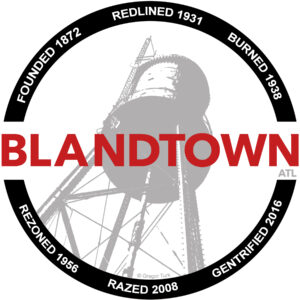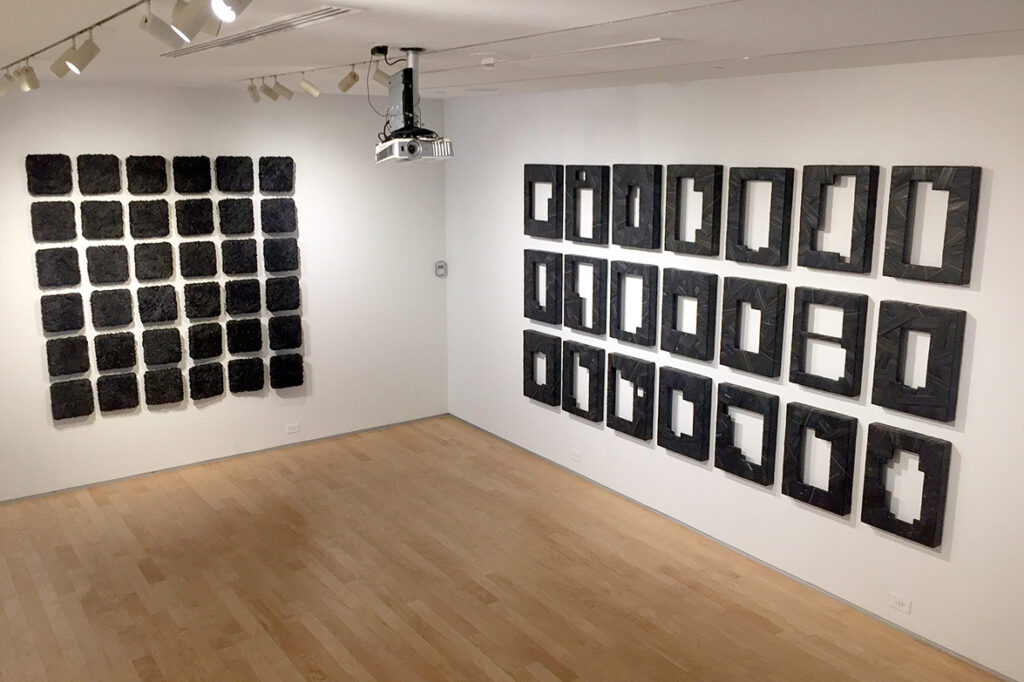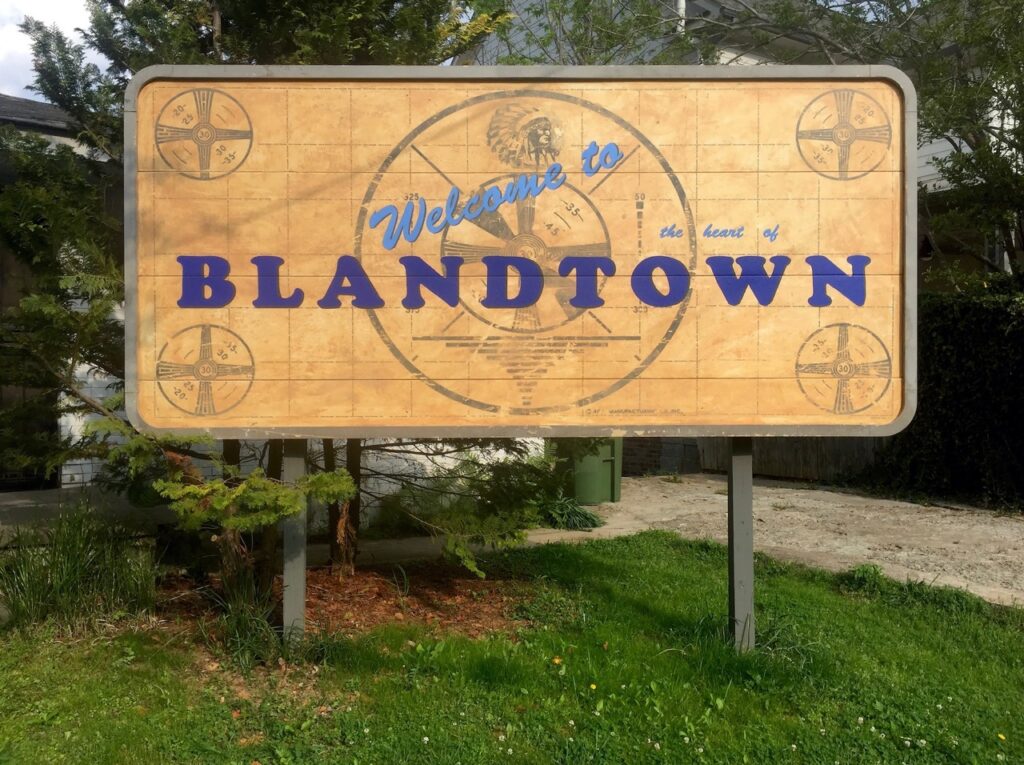
BLANDTOWN
Located in Atlanta, Georgia, the westside neighborhood is named after Felix Bland, whose parents, Samuel and Viney Bland, bought four acres of land during Reconstruction that became the community’s core, Blandtown thrived as a close-knit, African American community with 200 – 300 homes for over 80 years. In 1956 the neighborhood was rezoned from residential to heavy industrial by white business owners usurping the neighborhood association. This led to the residential neighborhood’s precipitous decline. Blandtown serves as a case study in Larry Keating’s Atlanta: Race, Class, and Urban Expansion as an example of the removal of black residential clusters from predominantly white portions of the city to minimize the black vote. With only four of the original homes remaining, Blandtown is experiencing a new wave of residential and commercial redevelopment. Since 2016 most of the original core of the neighborhood has been rezoned back to residential with over a hundred single family homes and hundreds of apartment units constructed.
GREGOR TURK STUDIO
Since 2003, Gregor Turk maintained his art studio in what was formerly one of these original homes. Built by Johnny Lee Green and Dorothy Nixon Green in the 1940’s, they raised 5 children in their home. Given the industrial re-zoning’s destructive impact on the residential community, the Green Family, like many of their neighbors, moved out in the 1970’s. In the 1980’s the house was sold to Wallace Bibbs, who also grew up in the neighborhood. Bibbs bought several properties as relatives and friends moved out. By 2003, the house had fallen into significant disrepair with only 20 other houses still standing. Because the house was constructed of concrete blocks (faced on the frontside with bricks from the nearby Chattahoochee Brick Company) the house was relatively structurally sound compared to the remaining wood-frame houses. The interior walls were gutted, and the structure was remodeled.
BLANDTOWN PROJECTS
As an artist that observes and seeks insight through mapping, cultural signage, and marking place, Turk often produces works that focus on geographic themes, specifically landmarks, markers, and borders. Over the years of working in his studio, Blandtown became his muse. In addition to interviews with former residents and thousands of photographs taken over the years, Turk has produced a substantial body of artwork that focuses on Blandtown’s history and land use changes. Exhibited in both galleries and public spaces, the work is intended to proclaim and reclaim the neighborhood’s name, history and consequently serve as an attempt to encourage reckoning.
BLANDTOWN BANNERS
Blandtown Banners features high-contrast photographs of Blandtown landmarks (former and remaining), infrastructure, and new construction projects that are accompanied by a word with the prefix “re”, offering up multiple interpretations through wordplay. Placed where traffic frequently backs up, my intent is to prompt a dialogue with viewers on Blandtown: its history, rapid development, and future. This program is supported by the City of Atlanta Mayor’s Office of Cultural Affairs through a Neighborhood Arts Grant in collaboration with the Upper Westside Improvement District, Blandtown Neighborhood Association, and the City of Atlanta Department of Watershed Management.
RECLAIM/PROCLAIM BLANDTOWN
Gallery 72, Atlanta, GA October 10 – November 27, 2019
This exhibition focuses on the demise and resettlement of the residential core of the westside Atlanta neighborhood of Blandtown, its history, recent rapid transformation, and its derided and consequently underutilized name.
HEART OF BLANDTOWN (HOB)
The façade of a large metal sign emblazoned with the phrase “Welcome to Heart of Blandtown” features a background image of an Indian-head test pattern, which was used from the late 1940’s to late 1970’s as a black and white television test pattern. Transmitted after television stations signed off for the night, the pattern indicated no programming was being broadcast. As this area of Blandtown adjusts its frequency and comes back on-the-air after most of the land was cleared, the objective of this artwork is to engage residents in a dialogue by reminding and/or informing them of the neighborhood’s name and history.
BLANDTOWN CONVERSATIONS
The first in an intended series of discussions on Atlanta’s Blandtown neighborhood. Conversation #1 features Turk’s dialogue with Dr. Rhana Gittens regarding her recent dissertation, Displacing the “Black Mecca”: Romanticizing or Witnessing African American Historical Trajectories in the Case of the Atlanta BeltLine, which focuses in part on Blandtown.
Dr. Gitten’s research of the neighborhood upended the long-held but inaccurate origin story of the neighborhood. Through primary research, specifically census records and deeds, she presented a historically accurate and corrected account of the neighborhood’s founding. While working concurrently (Gittens on her 2020 Ph.D. Dissertation, Displacing the “Black Mecca” and Turk on his 2019 Reclaim/Proclaim Blandtown exhibition) the two shared information and together interviewed former residents.
In this conversation, the neighborhood serves as a case study for current development, social justice, and land use issues relating to the greater city of Atlanta. This video component was supported by a Virtual Arts Initiative Grant through Fulton County Arts & Culture
RESOURCES
Newspaper articles featuring Blandtown
Dr. Rhana Gittens’ initial research on Blandtown’s history
Dr. Rhana Gittens’ disseration featuring Blandtown
Dr. Larry Keating’s book: Atlanta Race, Class and Urban Expansion available on Amazon
WERD History by Donna L. Halper (WERD transmission tower was located in Blandtown)
Image: 1949 aerial image of Blandtown (source and credit uncertain)







